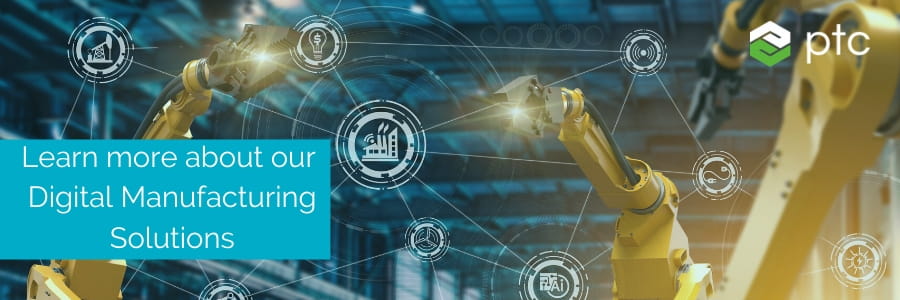IT vs OT: How the Two Halves of Digital Transformation Create Value Together
In manufacturing settings, the information technology (IT) and operational technology (OT/operations) systems have traditionally functioned independently. OT keeps the plant running smoothly, while IT systems managed back room business applications. More recently, the industrial internet of things (IIoT) has brought together the previously separate domains of OT and IT to create connected factories.
An IT-OT convergence is paving the way for information solutions that are redefining the competitive edge in manufacturing. The convergence enables:
- Collecting big data from across the value chain—and using it to enable real-time decision-making, or power intelligent automaton.
- Organization-wide collaboration which enables cross-functional knowledge to power greater insights.
- Controlled sharing of data between the “shop floor” and the “top floor” of the organization.
- More complex production line processes to be adopted, allowing manufacturers to keep up with the increased demands of consumers.
IT vs. OT: What’s the difference?
When considering IT vs OT in a manufacturing context, and how they are converging, we must understand why they have been functioning separately in the first place.
Information technology: People often associate information technology with business software. However, the term actually refers to the hardware, software, computers, and telecommunication devices that are involved in the running of essential business operations. This may include payment of staff, billing, revenue collection, plant communication, and project planning. Information technology is defined by how much programmable capacity it has. Information technology does not have a static function like an assembly robot or a piston. It can be reprogrammed and augmented to suit an increasingly complex manufacturing workplace.
Operating technology: Operating technology (OT) encompasses the real-time machinery and technologies that perform industrial operations. It is a variety of technologies including motors, metal presses, and assembly robots. Operating technologies traditionally have a set function that requires human oversight at key junctures.
These systems and technologies have been shaped by their respective responsibilities, a siloed approach to computing, and the respective pace of innovation. While factory hardware, machinery, and operations have evolved rapidly since the first assembly lines, OT did not undergo the same rapid explosion of digital transformation as business productivity systems.
From telecommunications, and personal computers, to the internet and massive, cloud-based data-heavy applications, IT has accelerated along a trajectory that has completely reshaped how knowledge workers operate. In contrast, OT systems and innovations are largely additive measures. While SCADA and HMI have provided remarkable increases in factory equipment productivity, their footprint in the overall factory is small. In addition, these are often siloed, proprietary systems. These separate functions and history also reflect that these systems are often developed by completely different companies. Companies that develop IT systems and OT systems have existed in independent swim lanes—at least until recently.
The value of a connected factory
There are several ways manufacturers can take advantage of the connectivity and enhanced networking of manufacturing tools and assets.
Simplified control
When the IT vs OT mindset was to keep them siloed, the means to control manufacturing processes were limited. In fact, control systems only required mastering technologies designed for a single purpose.
The IT-OT convergence, however, has enabled IT systems to play a more significant role in facilitating and managing processes on the manufacturing floor. For example, a temperature monitor that previously provided an employee with enough information to decide when to make an adjustment and perform a routine maintenance check could regulate temperature automatically using temperature sensors attached to an IT network.
Although the original manual process worked, it was labor-intensive, an inefficient use of employee time, and prone to human error, with the potential for costly unplanned downtime. The increased connectivity (i.e. an IoT-enabled manufacturing line) between machines, sensors, and humans has resulted in more responsive, agile processes–improving quality, efficiency, and control.
Real-time visibility
As a result of the IT-OT convergence, manufacturers can now turn the data generated by machines and processes into valuable insights. Previously, this aggregation of data required significant manual effort, pulling information from many different sources—and likely exceeded the technical means of a manufacturer. Now, the fact that machines, gateways, and sensors are all connected to a centralized information system, means a holistic picture can be formed. The result is real-time process visibility and a more thorough understanding of manufacturing processes. And more recently, solutions have been developed to make the connection and usability of this data more streamlined and scalable.
Eliminate unplanned downtime
Planned preventive maintenance schedules rule the day in most manufacturing settings. Operations teams perform preventive maintenance on a regular schedule to decrease the likelihood of equipment breakdowns. This approach relies largely on the manufacturers’ recommendations. Preventative maintenance is clearly better than just waiting until something breaks. However, it’s not perfect as maintenance is relying on best practices, rather than actual data. As a result, it can lead to unplanned downtime and waste—or maintenance that is unnecessary and intrusive.
Shifting to a predictive maintenance approach through IT-OT convergence reduces downtime, but also gives insights into when a device or system might fail. It connects data from machines, sensors, and analytics to give the data meaning. As smarter systems can predict problems, they respond accordingly (e.g. with alerts or automated changes in operations) to prevent unnecessary downtime.
IT-OT convergence: The future of manufacturing
As the IT vs. OT separation erodes and information is being utilized to its full potential, the convergence of these two areas is transforming manufacturing in ways neither function could have imagined. As these two groups work more closely together, they are able to unlock new opportunities in manufacturing.
Find out how you can start your digital transformation journey with PTC.
